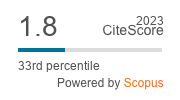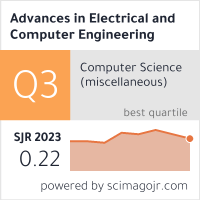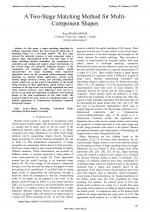| 1/2015 - 19 | View TOC | « Previous Article | Next Article » |
A Two-Stage Matching Method for Multi-Component ShapesHASSANPOUR, R. |
| View the paper record and citations in |
| Click to see author's profile in |
| Download PDF |
Author keywords
shape matching, articulated shape matching, medical image processing
References keywords
shape(19), recognition(15), pattern(15), retrieval(11), image(10), matching(8), vision(7), transaction(7), images(6), analysis(6)
Blue keywords are present in both the references section and the paper title.
About this article
Date of Publication: 2015-02-28
Volume 15, Issue 1, Year 2015, On page(s): 143 - 150
ISSN: 1582-7445, e-ISSN: 1844-7600
Digital Object Identifier: 10.4316/AECE.2015.01019
Web of Science Accession Number: 000352158600019
SCOPUS ID: 84924763811
Abstract
In this paper a shape matching algorithm for multiple component objects has been proposed which aims at matching shapes by a two-stage method. The first stage extracts the similarity features of each component using a generic shape representation model. The first stage of our shape matching method normalizes the components for orientation and scaling, and neglects minor deformations. In the second stage, the extracted similarity features of the components are combined with their relative spatial characteristics for shape matching. Some important application areas for the proposed multi-component shape matching are medical image registration, content based medical image retrieval systems, and matching articulated objects which rely on the a-priori information of the model being searched. In these applications, salient features such as vertebrae or rib cage bones can be easily segmented and used. These features however, show differences from person to person on one hand and similarities at different cross-sectional images of the same examination on the other hand. The proposed method has been tested on articulated objects, and reliable registration of 3-dimensional abdominal computed tomography images. |
| References | | | Cited By «-- Click to see who has cited this paper |
| [1] P. Daras, S. Manolopoulou, and A. Axenopoulos, "Search and Retrieval of Rich Media Objects Supporting Multiple Multimodal Queries", IEEE Transaction on Multimedia, vol. 14, no. 3, June 2012, [CrossRef] [Web of Science Times Cited 31] [SCOPUS Times Cited 33] [2] M. Worring and T. Gevers, "Interactive retrieval of color images", International Journal of Image Graphics, vol. 1, no. 3, pp. 387-414, 2001, [CrossRef] [SCOPUS Times Cited 12] [3] S.B. Kang and K. Ikeuchi, "The Complex EGI: A New Representation for 3D Pose Determination", IEEE Transaction on Pattern Analysis and Machine Intelligence, vol. 15, no. 7, pp. 707-721, 1993, [CrossRef] [Web of Science Times Cited 76] [SCOPUS Times Cited 117] [4] T. Zaharia and F. Prteux, "Shape-Based Retrieval of 3D Mesh Models", Proceedings of IEEE International Conference on Multimedia and Expo, 2002, [CrossRef] [Web of Science Times Cited 22] [SCOPUS Times Cited 65] [5] J. S. Nalewajko, S. Jezewski, R. Ambroziak, and M. Kuzariski, "Digital image processing methods in biological structure recognition - a short review", Proceedings of the 2nd International Conference on Perspective Technologies and Methods in MEMS Design, pp. 61-64, 2006, [CrossRef] [Web of Science Times Cited 2] [SCOPUS Times Cited 2] [6] C. C. Tappert, C. Y. Suen, and T. Wakahara, "The state of the art in online handwriting recognition", IEEE Transactions on Pattern Analysis and Machine Intelligence, vol. 12, no. 8, pp. 787-808, 1990, [CrossRef] [Web of Science Times Cited 426] [SCOPUS Times Cited 644] [7] Y. Mingqiang, K. Kidiyo, and R. Joseph, "A survey of shape feature extraction techniques", Pattern Recognition Techniques, Technology and Applications, ISBN: 978-953-7619-24-4, pp. 43-90, 2008, [CrossRef] [8] M. A. Fischler, and R.A. Elschlager, "The Representation and Matching of Pictorial Structures", IEEE Transactions on Computers, vol. C-22, no.1, pp. 67-92, 1973, [CrossRef] [SCOPUS Times Cited 974] [9] H. Sundar, D. Silver, N. Gagvani, and S. Dickson, "Skeleton based shape matching and retrieval", In Proceedings of Shape modeling International, Seoul, Korea, pp. 130-139. 2003, [CrossRef] [Web of Science Times Cited 338] [SCOPUS Times Cited 524] [10] D. Zarpalas, P. Daras, A. Axenopoulos, D. Tzovaras, and M. G. Strintzis, "3D model search and retrieval using the spherical trace transform", EURASIP Journal of Advanced Signal Processing, vol. 2007 no. 1, pp. 1-15, 2007, [CrossRef] [Web of Science Times Cited 25] [SCOPUS Times Cited 67] [11] S. Loncaric, "A survey of shape analysis techniques", Pattern Recognition, vol. 31, no. 8, pp. 983-1001, 1998, [CrossRef] [Web of Science Times Cited 619] [SCOPUS Times Cited 782] [12] R. Gal, and D. Cohen-Or, "Salient geometric features for partial shape matching and similarity", ACM Transaction on Graphics, vol. 25, no. 1, pp. 130-150, 2006, [CrossRef] [Web of Science Times Cited 327] [SCOPUS Times Cited 440] [13] A. Joly, O. Buisson, and C. Frelicot, "Content-based copy retrieval using distortion-based probabilistic similarity search", IEEE Transaction on Multimedia, vol. 9, no. 2, pp. 293-306, 2007, [CrossRef] [Web of Science Times Cited 167] [SCOPUS Times Cited 257] [14] C. B. Akgul, B. Sankur, Y. Yemez, and F. Schmitt, "3D Model Retrieval Using Probability Density-Based Shape Descriptors", IEEE Transaction on Pattern Analysis and Machine Intelligence, vol. 31, no. 6, pp. 1117-1133, 2009, [CrossRef] [Web of Science Times Cited 74] [SCOPUS Times Cited 106] [15] M. B. Cuadra, C. Pollo,A. Bardera, O. Cuisenaire, J. G. Villemure, and J. P. Thiran, "Atlas-Based Segmentation of Pathological MR Brain Images using a Model of Lesion Growth", IEEE Transaction on Medical Imaging, vol. 10, no. 23, pp. 1301-1314, 2004, [CrossRef] [Web of Science Times Cited 151] [SCOPUS Times Cited 191] [16] Q. Dai and K. J. Singleton, "Specification analysis of affine term structure models", Journal of Finance, vol. 55, pp. 1943-1978, 2000, [CrossRef] [Web of Science Times Cited 728] [SCOPUS Times Cited 842] [17] S. A. Shimizu, R. Ohno, T. Ikegami, H. Kobatake, S. Nawano, and D. Smutek, "Multi-organ Segmentation in Three Dimensional Abdominal CT Images", International Journal of Computer Assisted Radiology and Surgery (CARS), vol. 1, no. 7, pp. 76-78, 2006. [18] D. J. Montagnat, "Volumetric Medical Images Segmentation using Shape Constrained Deformable Models", CVRMed-MRCAS, Lecture notes in Computer Science, vol. 1205, pp. 13-22, 1996, [CrossRef] [SCOPUS Times Cited 49] [19] D. Y. Nakayama, Q. Li, S. Katsuragawa, R. Ikeda, Y. Hiai, K. Awai, S. Kusunoki, Y. Yamashita, H. Okajima, Y. Inomata, K. Doi, "Automated Hepatic Volumetry for Living Related Liver Transplantation At Multisection CT", Radiology, vol. 240, no. 3, pp. 743-748, 2006, [CrossRef] [Web of Science Times Cited 137] [SCOPUS Times Cited 148] [20] H. S-J. Lim, Y.-Y. Jeong, and Y.-S. Ho, "Automatic liver segmentation for volume measurement in CT Images", Journal of Visual Communication and Image Representation, vol. 17, no. 4, pp. 860-875, 2006, [CrossRef] [Web of Science Times Cited 99] [SCOPUS Times Cited 129] [21] K. J. Lee et.al, "Efficient liver segmentation using a level-set method with optimal detection of the initial liver boundary from level-set speed images", Computer Methods and Programs in Biomedicine, vol. 88, no. 1, pp. 26-38, 2007, [CrossRef] [Web of Science Times Cited 88] [SCOPUS Times Cited 115] [22] D. Huber. and M. Herbert, "Fully automatic registration of multiple 3d data sets", Image and Vision Computing, vol. 21, no. 7, pp. 637-650, 2003, [CrossRef] [Web of Science Times Cited 219] [SCOPUS Times Cited 284] [23] A. Frome, D. Huber, R. Kolluri, T. Bulow, and I. Malik, "Recognizing objects in range data using regional point descriptors", In Proceedings of the European Conference on Computer Vision (ECCV), 2004, [CrossRef] [24] V. Monga and B.L. Evans, "Perceptual image hashing via feature points: performance evaluation and tradeoffs", IEEE Transactions on Image Processing, vol. 15, no. 11, pp. 3452-3465,2006, [CrossRef] [Web of Science Times Cited 234] [SCOPUS Times Cited 312] [25] S. Belongie, J. Malik, and J. Puzicha, "Shape matching and object recognition using shape contexts", IEEE Transactions on Pattern Analysis and Machine Intelligence, pp. 509-522, 2002, [CrossRef] [Web of Science Times Cited 4075] [SCOPUS Times Cited 5398] [26] L. Xudong and Z. J. Wang, "Shape Context based Image Hashing using Local Feature Points", 18th IEEE International Conference on Image Processing (ICIP), pp. 2541 - 2544 , 2011, [CrossRef] [SCOPUS Times Cited 2] [27] B. Moghaddam, T. Jebara, and A. Pentland, "Bayesian Face Recognition", Pattern Recognition, vol. 33, no. 11, pp. 1771-1782, 2000, [CrossRef] [Web of Science Times Cited 406] [SCOPUS Times Cited 517] [28] X. Zhang, and Y. Liu, "Point Pattern Matching for Articulated or Multiple Objects", Proceedings of the 17th International Conference on Pattern Recognition (ICPR'04), vol.3, pp. 630 - 633, 2004, [CrossRef] [Web of Science Times Cited 2] [SCOPUS Times Cited 4] [29] D. G. Lowe, "Distinctive image features from scale-invariant keypoints," International journal of computer vision, vol. 60, no. 2, pp. 91-110, 2004. [30] H. Chui, and A. Rangarajan, "A New Algorithm for Non-Rigid Point Matching", Computer Vision and Pattern Recognition, vol. 2, pp. 44 - 51, 2000, [CrossRef] [31] L. J. Latecki, R. Lakamper, and T. Eckhardt, "Shape Descriptors for Non-Rigid Shapes with a Single Closed Contour", IEEE Conference on Computer Vision and Pattern Recognition, vol.1, pp. 424-429, 2000, [CrossRef] [32] M. Sharkas, and M. A. Elenien, "Eigenfaces vs. fisherfaces vs. ICA for face recognition; a comparative study", 9th International Conference on Signal Processing (ICSP 2008), pp 914-919, 2008, [CrossRef] [Web of Science Times Cited 24] [SCOPUS Times Cited 36] [33] K. Chakrabarti, M. O. Binderberger, K. Porkaew, and S. Mehrotra, "Similar shape retrieval in MARS", IEEE International Conference on Multimedia and Expo (ICME), vol. 2, pp. 709-712, 2000, [CrossRef] [34] T. L. Liu, D. Geiger, and R. V. Kohn. "Representation and self-similarity of shapes", International Conference on Computer Vision (ICCV), pp. 1129-1135, 1998, [CrossRef] [Web of Science Times Cited 48] [SCOPUS Times Cited 70] [35] Y. Rui, A. She, T. S. Huang, "A Modi?ed Fourier Descriptor for Shape Matching in MARS", Image Databases and Multimedia Search, pp. 165-180, 1998 [36] D. Zhang and G. Lu, "Review of shape representation and description techniques", Pattern Recognition, vol. 37, pp. 1-19, 2004, [CrossRef] [Web of Science Times Cited 1163] [SCOPUS Times Cited 1528] [37] S. Tabbone and O. Ramos Terrades and S. Barrat, "Histogram of Radon Transform. A useful descriptor for shape retrieval", 19th International Conference on Pattern Recognition (ICPR), pp. 1-4, 2008, [CrossRef] [SCOPUS Times Cited 32] [38] M. Heikkila, M. Pietikainen, C. Schmid, "Description of interest regions with local binary patterns", Pattern Recognition, vol. 42, no. 3, pp.425-436 2009, [CrossRef] [Web of Science Times Cited 852] [SCOPUS Times Cited 1140] [39] D. Chen, X. Tian, Y. Shen, O. Ming, "On visual similarity based 3D model retrieval", Computer Graphics Forum, vol. 22, no.3, pp. 223-232, 2003, [CrossRef] [Web of Science Times Cited 944] [SCOPUS Times Cited 1314] [40] T. Funkhouser, P. Min, M. Kazhdan, J. Chen, A. Halderman, D. Dobkin, D. Jacobs, "A search engine for 3D models". ACM Transaction on Graphics, vol. 22, no.1, pp. 83-105, 2003, [CrossRef] [Web of Science Times Cited 612] [SCOPUS Times Cited 869] [41] M. Zhang, L. Zhang, T. Mathiopoulos, Y. Ding, H. Wang, "Perception-based shape retrieval for 3D building models", ISPRS Journal of Photogrammetry and Remote Sensing, vol. 75, pp. 76-91, 2013, [CrossRef] [Web of Science Times Cited 18] [SCOPUS Times Cited 19] [42] T. Ma and L. J. Latecki, "From Partial Shape Matching through Local Deformation to Robust Global Shape Similarity for Object Detection", IEEE Conference on Computer Vision and Pattern Recognition (CVPR), pp. 1441-1448, 2011, [CrossRef] [SCOPUS Times Cited 74] Web of Science® Citations for all references: 11,907 TCR SCOPUS® Citations for all references: 17,096 TCR Web of Science® Average Citations per reference: 277 ACR SCOPUS® Average Citations per reference: 398 ACR TCR = Total Citations for References / ACR = Average Citations per Reference We introduced in 2010 - for the first time in scientific publishing, the term "References Weight", as a quantitative indication of the quality ... Read more Citations for references updated on 2024-10-19 23:51 in 261 seconds. Note1: Web of Science® is a registered trademark of Clarivate Analytics. Note2: SCOPUS® is a registered trademark of Elsevier B.V. Disclaimer: All queries to the respective databases were made by using the DOI record of every reference (where available). Due to technical problems beyond our control, the information is not always accurate. Please use the CrossRef link to visit the respective publisher site. |
Faculty of Electrical Engineering and Computer Science
Stefan cel Mare University of Suceava, Romania
All rights reserved: Advances in Electrical and Computer Engineering is a registered trademark of the Stefan cel Mare University of Suceava. No part of this publication may be reproduced, stored in a retrieval system, photocopied, recorded or archived, without the written permission from the Editor. When authors submit their papers for publication, they agree that the copyright for their article be transferred to the Faculty of Electrical Engineering and Computer Science, Stefan cel Mare University of Suceava, Romania, if and only if the articles are accepted for publication. The copyright covers the exclusive rights to reproduce and distribute the article, including reprints and translations.
Permission for other use: The copyright owner's consent does not extend to copying for general distribution, for promotion, for creating new works, or for resale. Specific written permission must be obtained from the Editor for such copying. Direct linking to files hosted on this website is strictly prohibited.
Disclaimer: Whilst every effort is made by the publishers and editorial board to see that no inaccurate or misleading data, opinions or statements appear in this journal, they wish to make it clear that all information and opinions formulated in the articles, as well as linguistic accuracy, are the sole responsibility of the author.





